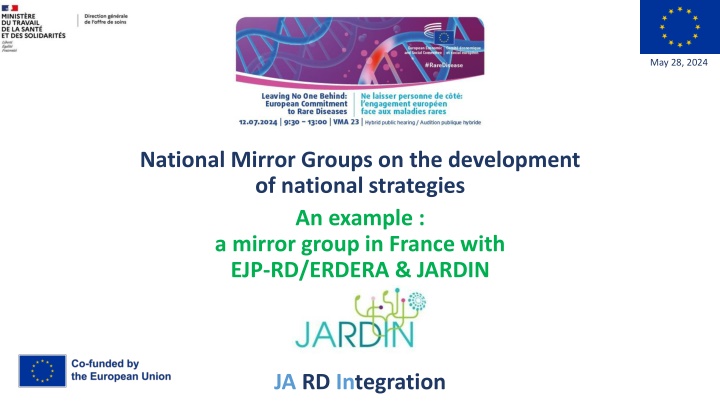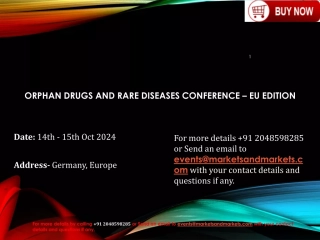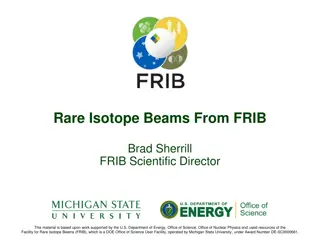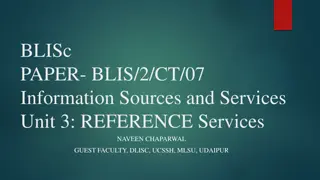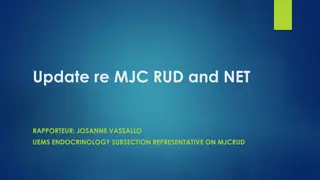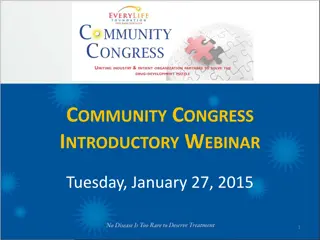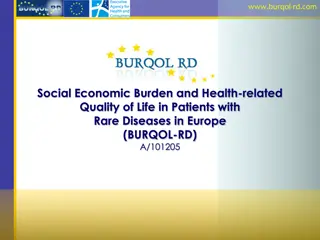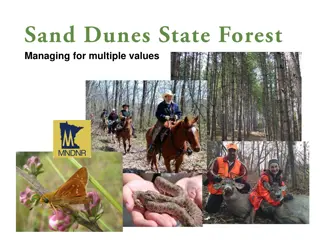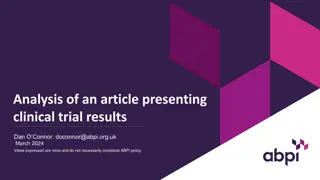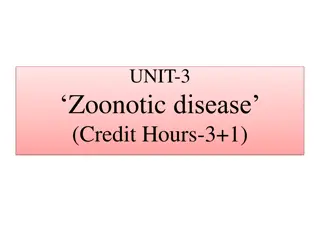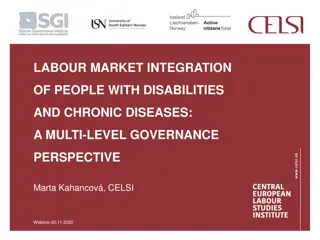Enhancing Integration of European Reference Networks for Rare Diseases
This project aims to improve the integration of European Reference Networks (ERN) into healthcare systems across member states, focusing on governance, quality assurance, patient pathways, and data management. By supporting national networks, implementing interoperable data sources, and ensuring sustainability, the initiative seeks to enhance the impact of ERNs in addressing rare diseases effectively.
Download Presentation

Please find below an Image/Link to download the presentation.
The content on the website is provided AS IS for your information and personal use only. It may not be sold, licensed, or shared on other websites without obtaining consent from the author.If you encounter any issues during the download, it is possible that the publisher has removed the file from their server.
You are allowed to download the files provided on this website for personal or commercial use, subject to the condition that they are used lawfully. All files are the property of their respective owners.
The content on the website is provided AS IS for your information and personal use only. It may not be sold, licensed, or shared on other websites without obtaining consent from the author.
E N D
Presentation Transcript
May 28, 2024 National Mirror Groups on the development of national strategies An example : a mirror group in France with EJP-RD/ERDERA & JARDIN JA RD Integration
JARDIN: General Presentation The 24 European Reference Networks (ERN) are multinational networks of highly specialized healthcare providers (HCP) across Europe in thematically coherent medical domains, addressing rare or low- prevalence complex diseases requiring exceptional concentration of expertise and resources. In this project, we aim to enhance the impact of the ERN even further by addressing all aspects of their better integration into healthcare systems in member states : Improving national governance of ERN-HCP, quality assurance models, patient pathways and ERN referral systems Supporting the formation of national reference networks and undiagnosed diseases programs or equivalent strategies interlinked with ERN Improving data management, aiming to finally achieve full interoperability of regional, national and European health data sources Identifying national support options for ERN-HCP A focus will be to ensure the sustainability of the proposed actions and implementations, which we propose to integrate into updated national plans and strategies for rare diseases in all member states.
National plans and strategies for rare diseases: Fondations to structure rare diseases ecosystem PNMR 1 PNMR 3 PNMR 2 PNMR 4 20182023 2011 2014 (18) 2004 (05)2008 (11) Structuring of FSMR 9 Hospitals Work on the establishment of the BNDMR AP-HP Hospital Rare Disease Foundation RDs became a public health issue 131 labelled CRMR in 120 French Hospitals 4th, July 2018 Third Rare Disease Plan (PNMR3)
- Make sure each patient receives a faster diagnosis and reduce diagnostic delay, with a quantified objective reduced to 1 year; A - Reinforce the structuring of databases in order to increase research plan potential; for what ? - Boost the role of clinical networks to coordinate the actions of the multiple players concerned and support certain key phases, such as delivery of the diagnosis; - Ensure greater clarity of the care pathway for both patients and their families; - Encourage innovation and make it accessible; - Put in place new neonatal screening programmes; - Reinforce France s role in Europe. 4 12/09/2024
Work Package 8 Data Management Anne-Sophie Lapointe Marco Roos Objectives Tasks Deliverables Identify current barriers to RD data sharing and inventory of existing solutions Implement solutions to improve semantic accuracy and interoperability of RD health data Propose and develop implementable solutions to overcome organizational, technical and legal barriers to integration of national health systems and ERN data management Test and implement solutions in agile mode Visualize RD Expert centres with ERN & NRN Develop recommendations ensuring the interoperability of data structures on MS level (local, regional, national) and ERN level Implementable solutions mapping SE Atlas V1 release Recommendations for organization of care pathways and referral systems to ERN Report on barriers to RD data sharing and existing solutions Recommendations for integration of data management between national health systems and ERN In a nutshell Create an integrated, secure and smooth data management system
D8.2: Recommendations for integration of data management between National Health Systems and ERN Task 8.4 Testing and implementing integration solutions in agile mode 8.4.1: Implementing WP8.2 and WP8.3 outputs across samples of HCPs among 4 pilot ERNs 8.4.2: Communicating data from EHR datasets for use in CPMS 8.4.3: Use of implemented RD datasets for monitoring HCP and ERN activities and for data exchange with ERN registries. WP8 -Data management: develop recommendations ensuring the interoperability of MS9-11 Implementable solutions prepared Preparation of implementable solutions in MS including implementation guidelines issued in 3 release cycles. Task 8.3 Implementable solutions to overcome organisational, technical, & legal barriers to integration of national health systems & ERN data management 8.3.1: Technical solutions between HCP and RD data management systems 8.3.2: Instruments facilitating legitimate (re)use of data 8.3.3: ERN-supporting data management policies and procedures Driving test cases data structures on MS level (local, regional, national) and ERN level Task 8.5 Visualisation of RD Expert Centres with ERNs and NRNs 8.5.1 Mapping the Orphanet expert centres, networks and patient organisations/alliances data set with the generic. SE-ATLAS data model. 8.5.2 Demonstration and evaluation of national visualisation in interested countries. 8.5.3 Definition of data transfer between Orphanet and SE-ATLAS and definition of individual national search start pages. 8.5.4 Patient-centred easy/fast-to- use design. 8.5.5 Demonstration and evaluation of national visualisation in interested countries. 8.5.6 Determine models and strategies for long-term sustainability. MS12 First version of adapted SE-Atlas released SE-ATLAS with national entry points and inclusion of Orphanet data is published and accessible through Orphanet Task 8.2 Implementable solutions to improve semantic accuracy and interoperability of RD health data 8.2.1:Inventorise and recommend semantic standards to unambiguously capture data and maximise their use across national healthcare systems and registries. 8.2.2: Facilitate the implementation of ORPHAcodes in Health Information Systems to harmonise European data sharing and analysis. D8.1:Report on barriers to RD data sharing and existing solutions Task 8.1 Identification of current barriers to RD data sharing and inventory of existing solutions 8.1.1: Baseline study of the journey of RD data for primary and secondary use at HCP, national, and ERN level.. 8.1.2: Identification of the main organisational, technical and legal barriers and existing candidate solutions to integration of data management between National Health Systems and ERNs for RD data sharing. Baseline: barriers for integration of data management between national health systems and ERNs for rare diseases Thanks M. Roos for the slide
Introduction Monthly Meeting Participants Austria Germany Bundesinstitut f r Arzneimittel und Medizinprodukte Klinikum der Johann Wolfgang von Goethe Universit t Universit tsklinikum Heidelberg Universit tsklinikum T bingen Universit tsklinikum W rzburg - Klinikum der Bayerischen Julius Maximilians Universit t Norway Helse Sorost RHF Oslo Universitetsykehus Medizinische Universit t Wien Belgium Sciensano Portugal Ministerio da Saude - Republica Portuguesa Czech Republic Vseobecna Fakultni Nemocnice V Praze Slovakia Ministry of Health of the Slovak Republic Denmark Aarhus Universitetshospital Ireland Slovenia Univerzitetni Klinicni Center Ljubljana Health Service Executive Estonia Sihtasutus Tartu Ulikooli Kliinikum Italy Sweden Socialstyrelsen Veneto Region Finland Terveyden Ja Hyvinvoinnin Laitos Lithuania Viesoji Istaiga Vilniaus Universiteto Ligonine Santaros Klinikos France Assistance Publique H pitaux de Paris Hospices Civils de Lyon Institut National de la Sant et la Recherche M dicale / Orphanet Minist re de la Sant - DGOS Netherlands Academisch Ziekenhuis Leiden Stichting Radboud Universitair Medisch Centrum Competent authorities in the country of origin
French Mirror Group Key information Objectives Create a space for exchange and discussion on Jardin s topics and links with partners as EJP-RD and ERDERA => Track progress on each task Serve as a pilot group for all the work done in WP8 tasks Facilitators Anne-Sophie Lapointe Nandini Mourouvapin Participants Experts (Orphanet, BNDMR, Inserm / EJP-RD ) Healthcare professionals Professors & researchers ERN representatives Hospital IT leads Ministry of Health and Research Foster Jardin s actions at the local, regional and national levels Share best practices in a continued improvement logic between Health (JARDIN) and research (EJP-RD) => Align our ways of working => Improve our work: give coherence Date & time Every fourth Monday of the month at 1pm Address pain points: Agile method
Introduction Why Mirror Groups are important ? Articulate synergies between JARDIN & EJP-RD/ ERDERA Solve RD (Lead : Pr Holm Graessner) Solve a larger number of rare diseases and improve diagnostics by implementing a genetic knowledge web WP7 Lead : Pr Holm Graessner : national reference networks and undiagnosed disease programs linked with ERN WP8 : data management Erica (Lead : Pr Franz Schaefer) Build on the strength of the individual ERNs and create a platform that integrates all ERNs research and innovation capacity Task 8.1 Lead : Pr Franz Schaefer: Identify current barriers to rare diseases data sharing and map existing solutions FAIR (Lead : Pr Marco Roos) Make all data Findable, Accessible, Interoperable & Reusable to allow data exchange and optimal analysis Task 8.3 Lead : Pr Marco Roos: Propose concrete solutions to overcome existing barriers
Introduction Why Mirror Groups are important ? Articulate synergies between JARDIN & EJP-RD/ ERDERA / National Plan 23 National Rare Diseases Network: Observatories for the diagnosis of rare diseases / Genomic medicine and links with the France Genomic Medicine Plan (PFMG) Medical biology laboratories in liaison with clinicians for functional validations / Solve RD (Lead : Pr Holm Graessner) WP7 Lead : Pr Holm Graessner WP8 : data management Task 8.1 Lead : Pr Franz Schaefer: The rare disease treatment observatory The collection of real-life data for early access and compassionate use Supporting market access for innovation in rare diseases Erica (Lead : Pr Franz Schaefer) EJP-RD Pillar 2 Franz and Ana OD4RD2 8.2 Lead Ana Rath From the French national rare disease registry (BNDMR) towards ITHACA ERN registry (ILIAD): Data reusability to ease the burden of data entry Task 8.3 Lead : Pr Marco Roos: FAIR (Lead : Pr Marco Roos)
French National Registry for Rare Diseases Data entries in BaMaRa : ERNs Registries French Minimal Data Set (SDM) Specific data by disease, where applicable Data transfer into ERNs registries + Data transformation in BaMaRa: Pseudonymisation of patient data with SPIDER, European tool required in the Set of Common Data Elements (CDE) In others European Union s countries: Others systems Checking regulatory aspects : patient consent, agreements Mapping between French Minimal Data Set (SDM) and Common Data Elements (CDE) including translation https://eu-rd-platform.jrc.ec.europa.eu/set-of-common-data-elements_en
Involved partners : the 3 Neuro ERNs and ITHACA (for the genetic and neurodevelopmmental issues), supported by French registry on RD Alexis Arzimanoglou + EpiCARE registry data manager Holm Grae ner Teresina Evangelista Institut f r Medizinische Genetik und angewandte Genomik T bingen + ERN-RND registry data manager Assistance Publique-H pitaux de Paris (Piti Salp tri re) + Euro-NMD registry data manager Alain Verloes Arnaud Sandrin Assistance Publique-H pitaux de Paris (BNDMR) + BNDMR data manager Assistance Publique-H pitaux de Paris (Robert- Debr ) + ITHACA registry data manager
STRENGTHS WEAKNESSES Consistency between DG Sant & DG Research: ERN Registries Lack of knowledge about rare diseases fields Training GP and specialists RD: Efficiency between health and research Small cohorts with rare diseases / Heterogeneity Differents national regulations Integration EU level at national level: more aligned Secure the data ecosystem but also the all environment the city-hospital link Transparency MIRROR GROUPS THREATS OPPORTUNITIES From top to bottom Virtuous Circle for democratie: ex. FAIR Principles Lack of political interest about rare diseases fields Better coordination national and EU levels: new health and research projects together ? Work in silos EU RD Action Plan Lack of sharing views between health and research Smooth data management system Reinforce dissemination in 27 EU countries Lack of professionals : ex. bioinformaticians Empower Rare diseases community
